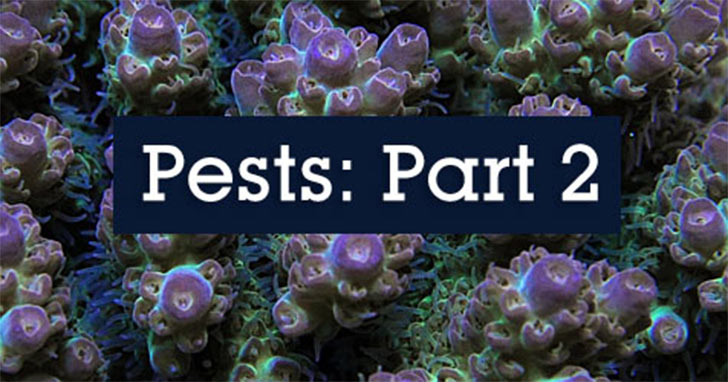
Over the past decade, the marine aquarium hobby has enjoyed advancements in both technology and information regarding the captive care of live coral. As a result, many organizations and hobbyists have begun fragmenting and producing corals that are offered for sale in the marketplace, and traded among hobbyists. These corals, commonly referred to as "Frags," include a large number of SPS (Small Polyp Stony Corals), LPS (Large Polyp Stony Corals), Soft Corals, Zoanthus Polyps and Mushrooms.
These species normally adapt very well to a captive environment, but unfortunately numerous pests and parasites have also reared their presence in home aquariums across the country. With the practice of swapping coral frags among hobbyists, club members, and the aquaculture facilities themselves, the presence of these pests in the U.S. is increasing at an alarming rate.
Here's what every hobbyist needs to know about the identification and prevention of common "frag" pests that are finding their way into home reef aquariums.
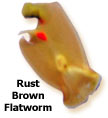 Flatworms
Flatworms
Identification
While Flatworms, also known as Planaria, can become a problem in just about any saltwater aquarium; the aquaculture industry has encountered two distinct types of flatworms that are now fairly common in the United States.
Rust Brown Flatworm
The first and most common type of flatworm can become a nuisance quickly in the home aquarium. These organisms are tan, brown or rust colored with a red dot, and reach a size of up to 1/4" in length. They are oval and slightly elongated with two tail-like appendages at their posterior. This brown flatworm has been identified as Convolutriloba retrogemma, and will proliferate rapidly in aquariums with elevated nutrient levels. The populations of these pests can increase to a point where they will actually perch on corals, and block the light from reaching the corals' tissue. Some experts believe that the flatworms actually feed on the zooxanthellae from coral tissue, thus damaging the corals themselves.
Acropora-eating Flatworm
 The Acropora Flatworm is starting to become prevalent in the United States, and has been recognized in Germany for the last few years. This unidentified species is a more aggressive species of flatworm that consumes the actual tissue of Acropora sp. corals at a rapid rate. This flatworm is white to opaque in color, and is mostly oval in shape, making them very difficult to notice in the display aquarium. They seem to prefer species of Acropora that have shorter polyps, and are most commonly found on Staghorn types and Tricolor species. This flatworm is very invasive, and immediate action should be taken if noticed in your aquarium.
The Acropora Flatworm is starting to become prevalent in the United States, and has been recognized in Germany for the last few years. This unidentified species is a more aggressive species of flatworm that consumes the actual tissue of Acropora sp. corals at a rapid rate. This flatworm is white to opaque in color, and is mostly oval in shape, making them very difficult to notice in the display aquarium. They seem to prefer species of Acropora that have shorter polyps, and are most commonly found on Staghorn types and Tricolor species. This flatworm is very invasive, and immediate action should be taken if noticed in your aquarium.
Symptoms & Signs
The Rust Brown Flatworm can be seen on top of corals, and normally in areas of low flow in the reef aquarium. The Acropora-eating Flatworm can be recognized by the rapid tissue loss in certain colonies of Acropora, and their presence will be known by the gold to brown egg masses that they leave behind on the bare coral skeletons.
Treatment
The best way of controlling flatworms is by prevention. Maintaining low nutrient levels in the aquarium with the use of carbon and aggressive protein skimming, along with increased water flow will help to reduce the populations of these pests. Proper
quarantine of new specimens, and all aquatic life before they are placed in the display aquarium will keep the initial introduction of flatworms to a minimum.
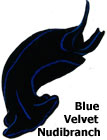
- Natural means of control include: Wrasse of the genus Pseudocheilinus, such as the
Six Line Wrasse (P. hexataenia), Halichoeres Wrasse, such as
Yellow Wrasse (H. chrysus), Macropharyngodon Wrasse such as the numerous
Leopard Wrasse (Macropharyngodon sp.), and
Dragonets such as the
Spotted Mandarin (Synchiropus picturatus). The
Blue Velvet Nudibranch (Chelidonura varians)
is very effective at consuming flatworms in the aquarium, but is very sensitive to changes in water chemistry and has a short life expectancy in the home aquarium.
- Although the species mentioned above will consume flatworms, they may not feed on all of the different species that inhabit the aquarium, nor will they typically rid the aquarium completely. Also be sure that your aquarium is appropriate for the fish, as some of the species do have special requirements and increased care levels in the home aquarium.
- Another method of removing flatworms from an infected colony is by performing a brief freshwater bath or dip. Flatworms are very sensitive to salinity changes; by dipping the colony in dechlorinated freshwater for 5 to 10 seconds and then shaking the colony while submerged in the bath of freshwater, will cause the worms to lose their grip and fall to the bottom of the container. Be sure the freshwater has the same temperature and pH as the aquarium's water in order to reduce the amount of stress on the colony.
- The last method involves manual removal. Siphoning seems to work the best, as the flatworms do not keep a very strong grip on the colony. A small diameter
airline tubing works very well for soft leather coral colonies and some species of mushrooms. Be careful not to damage the coral with too strong of a siphon. For the more delicate mushrooms and LPS corals, small syringes work very well. It is possible to get the syringe very close to the flatworm and gently draw the worm into the syringe without harming the coral.
With severe infestations, you may have to employ a combination of all methods mentioned above in order to eliminate or even control the populations of these pests.
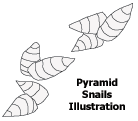 Pyramid Snails
Pyramid Snails
Identification
Pyramid Snails, or Pyrams are very small snails that belong to the Pyramidellidae family. They are generally white in color, have a slender shell that tapers to a point, and do not grow larger than a few millimeters. The Pyramid Snails use their long proboscis, which is a tube-like mouth, to puncture the mantle of a
Tridacna Clam in order to feed upon the fluids and zooxanthellae cells contained within. A few snails will typically not pose a threat to a healthy Tridacna Clam. The snails reproduce every 90-120 days, and if left to multiply, can cause serious harm or even death to their host in a very short period of time.
Signs & Symptoms
Evidence of an inflicted clam can be noticed by poor expansion and loss of color within the mantle. The Pyramid Snails feed mostly during the nighttime hours. During the daytime, they will remain either at the base of the clam, or within the scutes of the shell, where they are difficult to spot. It is best to inspect an ailing clam with a flashlight a few hours after the lights have turned off on the aquarium. The small snails will line up at the top of the shell just below the clam's mantle.
Treatment
If you discover these snails, it is best to remove the clam to a separate container of aquarium water. Once out of the aquarium, you can physically remove the adult snails, and brush the entire shell with a new toothbrush in order to remove any eggs.
Natural predators of Pyramid snails include several species of wrasse within the genus of Halichoeres and Pseudocheilinus. A few of the more popular species that are reportedly very efficient at controlling these snails are;
Six and
Eight Lined Wrasse (P. hexataenia and P. octotaenia), and the
Green Wrasse (H. chloropterus).
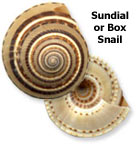 Box Snails
Box Snails
Identification
A snail that is regularly encountered in the aquaculture and aquarium industry is commonly referred to as a Box or Sundial Snail of the genus Heliacus. They have a classic shaped shell that is round at the base and twists upward into a point. Tan and brown colorations alternate within the striations of the shell, giving it a rather beautiful appearance.
Signs & Symptoms
The Box Snails are guilty of consuming many different types of colony polyps within the Zoanthus, Palythoa and Protopalythoa genus. Many times the snail will be found within the colony itself, where they puncture the base of the polyp, and feed upon its tissue and fluids. The polyp is then basically left as an empty shell, which quickly falls off of the rock and decomposes.
Treatment
The best method for controlling the populations of these snails is to physically remove them from the aquarium when discovered. These pests will not typically reproduce in a rapid manner, and physical removal should be sufficient.
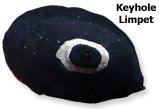 Limpets
Limpets
Several different genus and many species make up the snail-like invertebrate family, commonly known as limpets. Limpets have an oval, laterally compressed shell that tapers to an off-centered blunt point. Limpets have a tiny hole at the crest of their shell where it becomes a point, which they use for waste and water exchange. Many of these species have a very large mantle that extends around and covers the shell. In fact, some limpets can be very beautiful with amazing colors, and make a welcome guest in an aquarium that does not contain SPS corals.
The most common variety encountered in a reef aquarium is the
Keyhole Limpet. They are a common import with live rock, and are typically colored in a mottled brown, black and tan pattern, and do not have a mantle that covers their shell. The Keyhole Limpets are typically half an inch long, or smaller, and feed on unwanted filamentous algae, cyanobacteria, diatoms and even hydroids. Unfortunately, in the SPS aquarium, they will also feed on the tissue of SPS corals.
As with many of the snail species, it is best to physically remove the limpet if you are unsure of its species and diet. Some limpet species are herbivores and are beneficial to even a reef aquarium. But even the herbivores can become harmful if there is not enough food for them in the aquarium. Limpets will typically not reproduce to any significant number in the aquarium, and physical removal is usually a sufficient control for the SPS coral aquarist.
How to Reduce the Chances of Infecting Your Aquarium
The best remedy to these pests is by not introducing them into your aquarium, following proper
quarantine procedures for all aquatic inhabitants, including corals, plants and invertebrates. Only purchase healthy specimens from a reputable vendor that is aware of these pests, and takes every precaution in order to not spread them to others. Your vendor should practice proper husbandry and quarantine procedures, keep a close eye on their holding systems, and should perform the appropriate treatments if the need arises. Ask your vendor what protocols they employ in keeping their system free of pests and pathogens.
Also when trading frags with a fellow hobbyist, do not take his word that his system is free and clean of pests. We cannot stress enough the importance of quarantining all new specimens until you are sure that the colony is free of any unwanted organisms and have adjusted to their new environment. This is also a great time to slowly acclimate your new arrivals to both the water conditions and the type of
lighting that is used on your main system.
A reef aquarium offers us a unique ability to enjoy some of nature's most beautiful creatures in the comfort of our homes. Although mostly a relaxing hobby, there are times that it can become frustrating. The pests mentioned in this article can take the joy out of a reef aquarium making it a real burden. It is important to take preventive measures whenever adding new colonies to your display aquarium, as well as acting immediately if pests or parasites are ever noticed.
|
Part 1 | Part 2 |
|